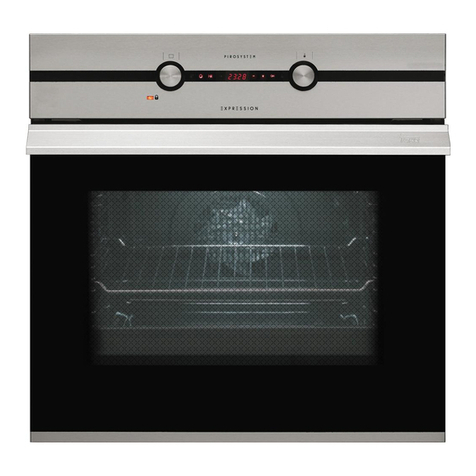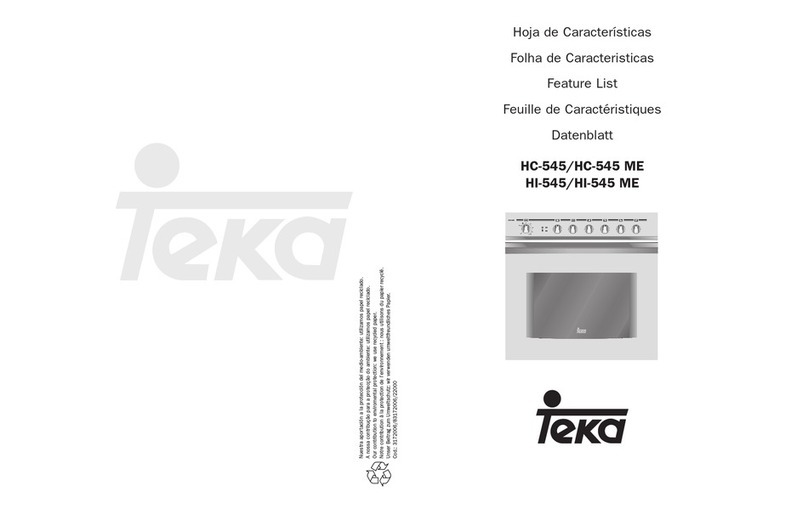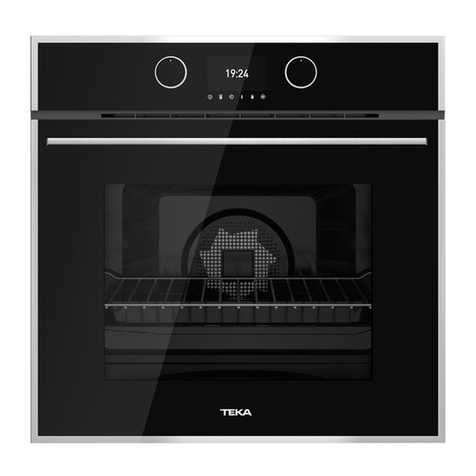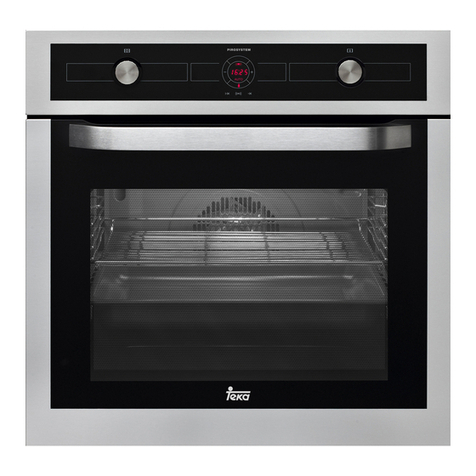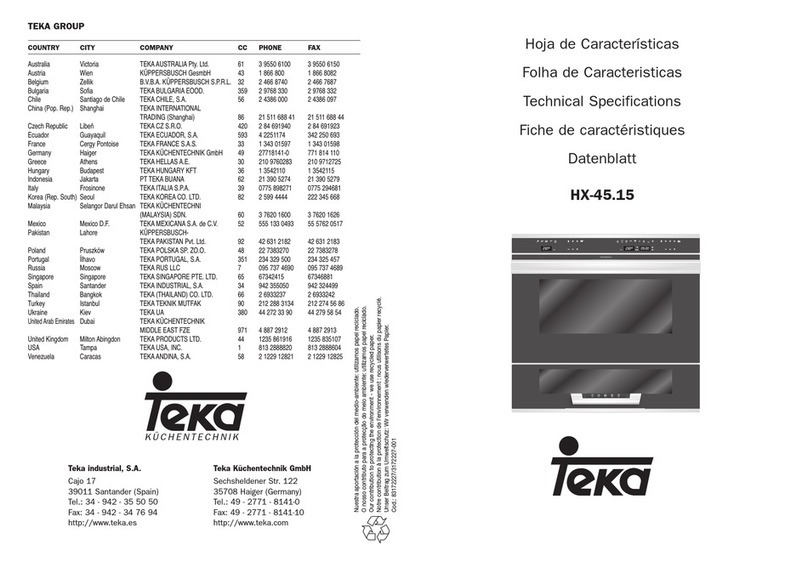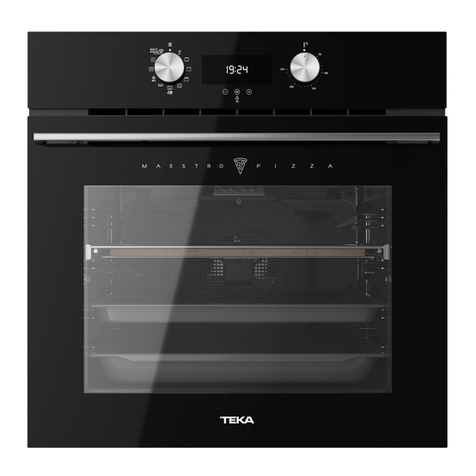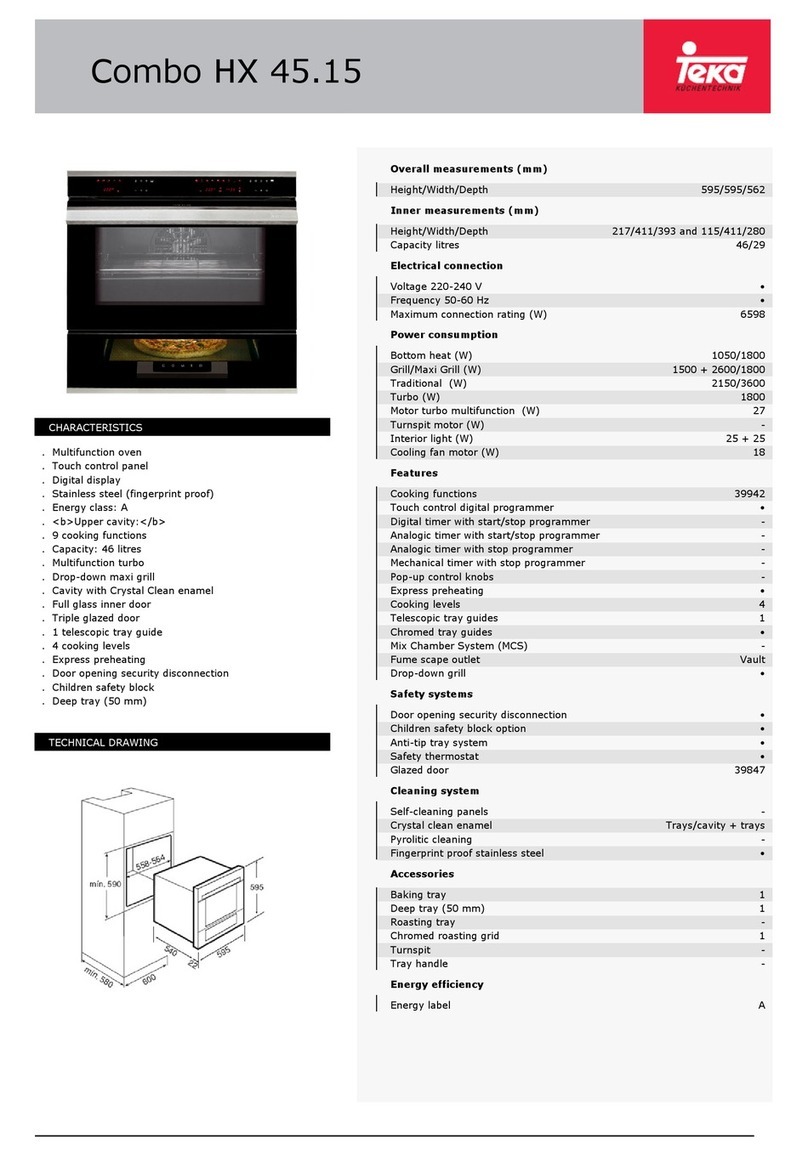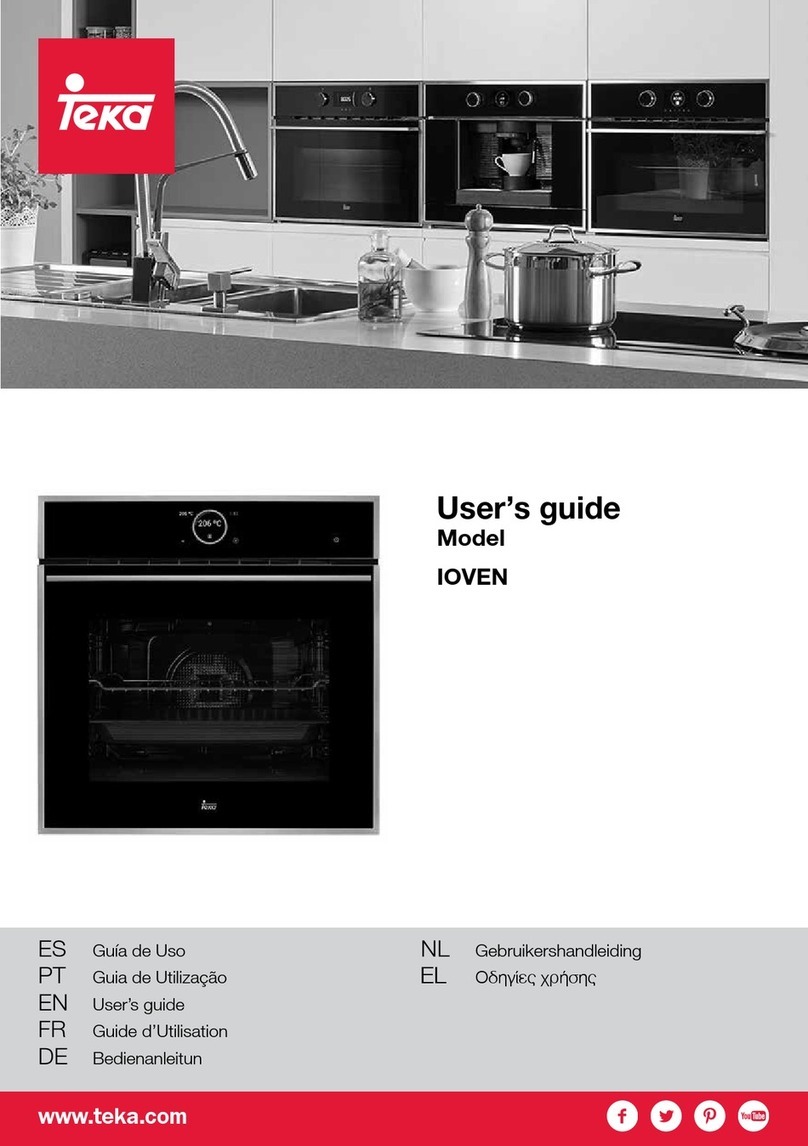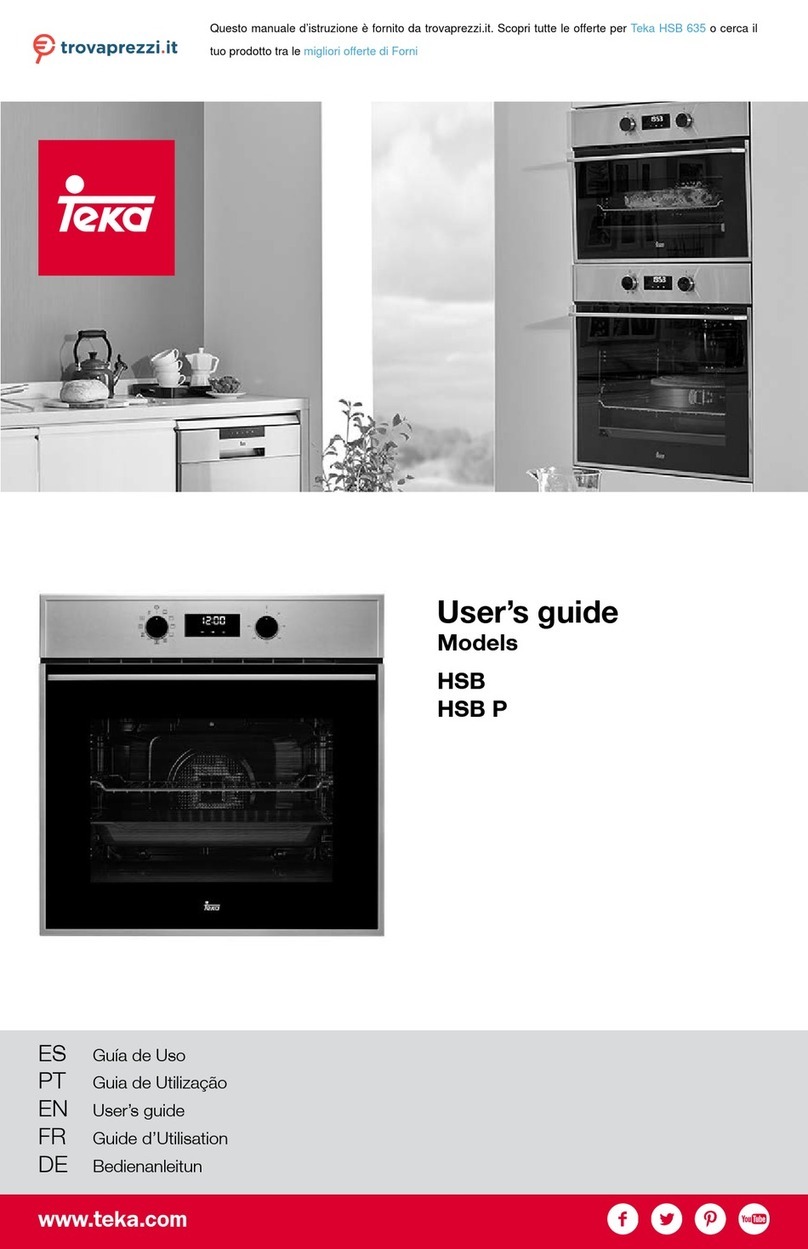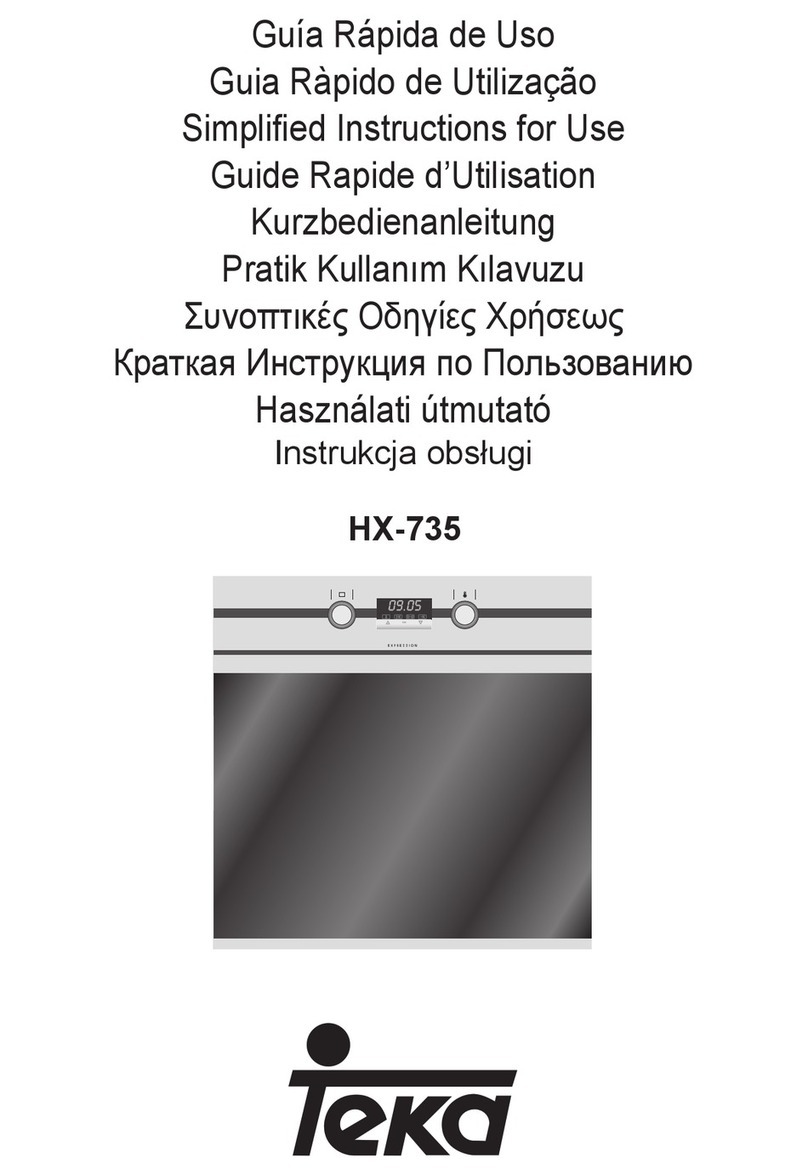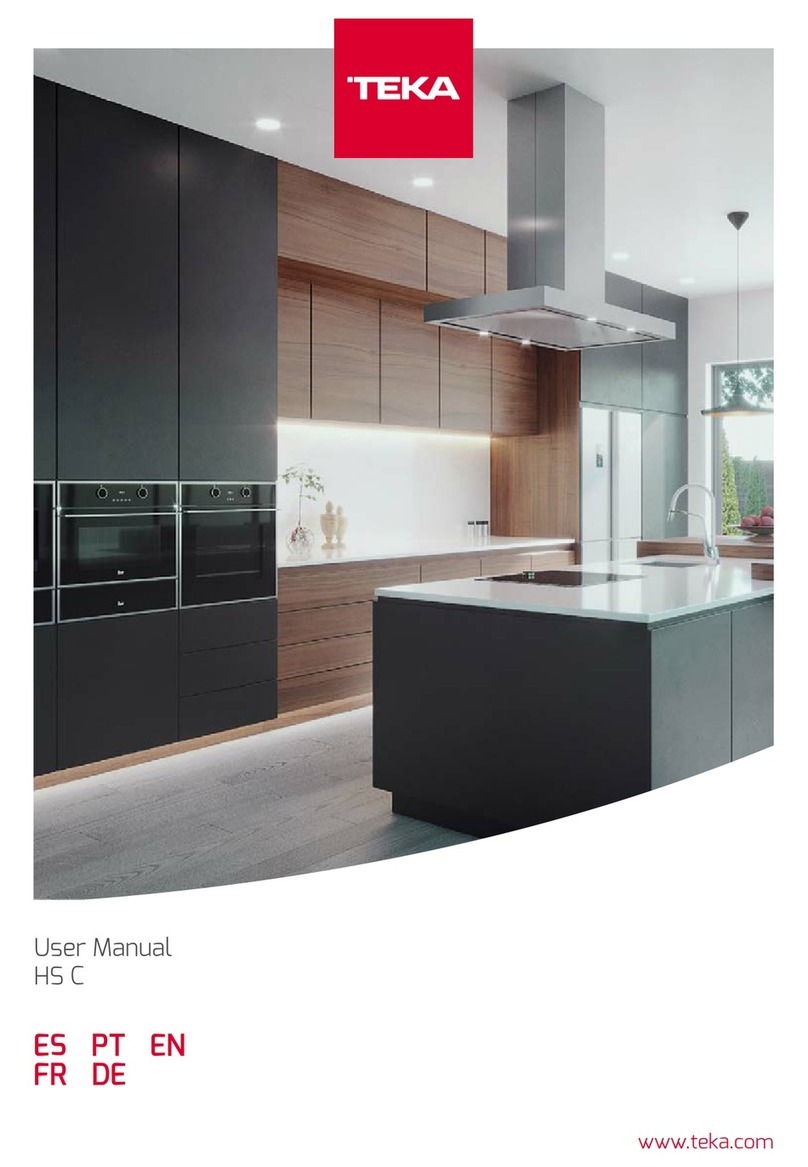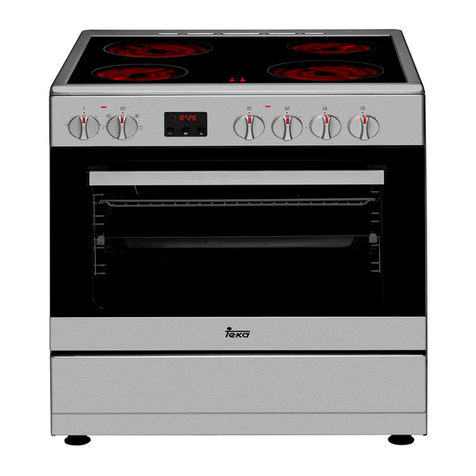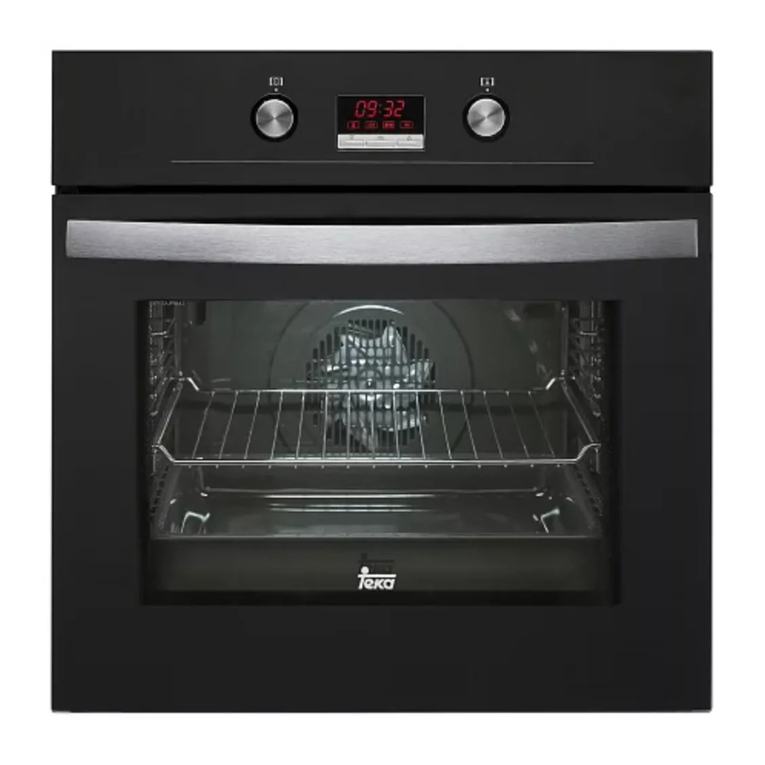PORTUGUÊS ENGLISH
12 28
Tabela de tempos de cocção por convexão
e tradicional (I)
Para a cocção de doces:
Os doces necessitam de uma temperatura moderada (em regra
geral, entre 150 e 200º C.) e precisam de um aquecimento prévio
do forno (à volta de 10 minutos). A porta do forno não deve ser
aberta antes de que tenham decorrido, no mínimo, 3/4 do tempo
de cocção. As massas batidas devem despegar-se da faca com
dificuldade, visto que a excessiva fluidez prolongaria inutilmente
o tempo de cocção.
Para a cocção de carnes e de peixes:
A carne que se cozinhar no forno deverá pesar, no mínimo, 1 Kg.,
a fim de evitar que seque demasiadamente. As carnes vermelhas
muito tenras que devem estar bem cozinhadas na parte exterior
e conservar todo o seu molho, necessitam, durante um breve
período de tempo, de uma cocção a alta temperatura (200 - 250º
C.). As carnes brancas, as aves e os peixes necessitam de uma
cocção a baixa temperatura (150 - 175º C.). Os ingredientes do
molho só se colocarão imediatamente na bandeja se o tempo de
cocção for breve; no caso contrário, juntar-se-ão durante a última
meia hora. O grau de cocção pode ser verificado ao espetar a
carne com uma faca; se ela não ceder, é porque já se encontra
cozinhada no seu ponto preciso. Para o rosbife, a carne cujo
interior deve permanecer rosada, o tempo de cocção deverá ser
breve. As carnes podem colocar-se num prato resistente à
temperatura do forno ou directamente em cima da grelha, sob a
qual se colocará a bandeja para recolher o molho. Quando a
cocção tiver finalizado, torna-se aconselhável esperar, no mínimo,
uns 15 minutos antes de cortar a carne, a fim de evitar que
resseque. Antes de serem servidos, os pratos podem aquecer-
se no forno, a uma temperatura mínima.
Cocção no grill ventilador
Consegue-se o funcionamento combinado do grill e do rotor. Este
tipo de cocção permite que o calor penetre gradualmente no
interior dos alimentos, até mesmo quando a superfície estiver
exposta à acção directa do grill.
Apropriada para:
– Carnes de uma grande espessura.
– Aves.
Cocção no grill
O calor provém da parte superior.
Apropriada para:
– Carnes de uma pequena espessura.
– Tostas.
Conselhos para a cocção no grill
Quase todas as carnes podem ser cozinhadas no grill, à excepção
de algumas carnes magras de caça e carnes enchidas. As carnes
e os peixes que se cozinharem no grill devem ser ligeiramente
untados com azeite e sempre colocados na grelha, a qual, por
sua vez, será colocada na guia mais perto ou mais afastada do
grill, conforme for a espessura da carne, a fim de assim poder
evitar que a superfície fique queimada e que o interior permaneça
cru. Ao verter um ou dois copos de água na bandeja, evita-se a
formação de fumo devido às gotas de molho e de gordura.
Na cocção no grill, a bandeja deve sempre ser colocada na
guia inferior.
Tempo de cocção
Os tempos de cocção podem variar de acordo com a natureza
das comidas, da sua homogeneidade e do seu volume. É
aconselhável vigiar a primeira cocção e verificar os resultados
obtidos, a fim de que, ao confeccionar os mesmos pratos nas
mesmas condições, se obtenham resultados similares. A título
de indicação, apresentamos duas tabelas de cocção. A Tabela I
informa sobre os tempos de cocção, as temperaturas e a posição
dos alimentos no interior do forno, para os alimentos cozinhados
por convexão; pelo contrário, a Tabela II proporciona a mesma
informação para a cocção no grill.
1. Os tempos de cocção foram estabelecidos depois de um
aquecimento prévio do forno, de cerca de 15 minutos.
2. A eleição das guidas é livre no caso de cocções a vários níveis.
3. Os tempos fazem referência à cocção a vários níveis, aumentar
o tempo de 5 a 10 minutos.
4. Para os assados de carne de vaca, vitela, porco e peru com
osso ou enrolado, aumentar o tempo em 20 minutos.
A bandeja que recolhe o molho das cocções deve estar sempre
colocada na guia inferior do horno.
Conselhos para a cocção tradicional
Tipo de cocção
Quantidade
N. Guia a Temperatura Tempo
Kg. partir de baxio C° em min.
Convex. Tradic. Convex. Tradic.
Doces
Com massa batida, em molde 11-3 2175 200 60
Com massa batida, em recipiente engordurado 11-3 2175 200 50
Massa folhada, fundo de tarte 0,5 1-3 3175 200 30
Massa folhada, com recheio húmido 1,5 1-3 2175 200 70
Massa folhada, com recheio seco 11-3 2175 200 45
Com massa de levedura natural 11-3 1175 200 50
Pequenos doces 0,5 1-3 3160 175 30
Carnes
Vitela 1 2 2 180 200 60
Vaca 1 2 2 180 200 70
Rosbife à inglêsa 1 2 2 220 220 50
Porco 1 2 2 180 200 70
Frango 1-1,5 2 2 200 200 70
Guisados
Guisado de vaca 1 1 2 175 200 120
Guisado de vitela 1 1 2 175 200 110
Peixes
Filetes, pescada, linguado 11-3 2180 180 30
Cavala, rodovalho, salmão 11-3 2180 180 45
Ostras 1-3 2180 180 20
Pasteis
Pasteis de massa seca 21-3 2185 200 60
Pastel de verduras 21-3 2185 200 50
Soufflés doces e salgados 0,75 1-3 2180 200 50
Pizza e empanadas 0,5 1-3 2200 220 30
Descongelação
Pratos rápidos 1 2 200 45
Carne 0,5 250
Carne 0,75 270
Carne 1 2 110
Tabela de tempos de cocção no grill- ventilador (II)
GRILL TRADICIONAL
Tipo de cocção Quantidade N. Guia a Temperatura Tempo
Kg. partir de baixo C° em min.
pos. grelha
Frango 1-1,5 3máx 30/lado
Tostas 0,5 4máx 5/lado
Salchichas 0,5 4máx 10/lado
Costeletas 0,5 4máx 8/lado
Peixes 0,5 4máx 8/lado
GRILL VENTILADOR
Tipo de cocção Quantidade N. Guia a Temperatura Tempo
Kg. partir de baixo C° em min.
pos. grelha
Assado de porco 1,5 2170 180
Rosbife 1,5 3220 60
Frango 1,2 2190 90
Traditional baking
Turn the functions knob to the symbol and then turn the
thermostat knob (fig. 2) to the required temperature. Preheating
of the oven is recommended until the thermostat indicator light
switches off, to show the selected temperature has been reached
in the center of the oven. This function is recommended for the
foods needing highest cooking temperatures or in earthenware
pots. When you want to cook your food heating it from bottom
turn the function knob to the symbol and to the symbol when
you want to heat the food from the top. With this cooking one tray
only, centrally placed, has to be used.
Wishing a more uniform warming of the oven turn the function
knob to the symbol favourable also when using more than
one tray.
Forced convection baking
Turn the function knob (fig. 1) to the symbol , then turn the
thermostat knob (fig. 2) to required temperature. With this function
more than on tray may be used at the same time because hot air
is forced by the fan around the food and between the trays and
also the temperature to be selected for cooking is 10-15% lower
than the corresponding value for traditional baking and the action
of the hot air will do more uniformly dried and crust your food.
When using one tray only the lower runner is suggested to be used
in order to have easier check by the oven window without opening
the door: in any case when you should open the door a safety
device will switch off the fan and the heating element in order to
save energy and avoid the whiff of air and steam against your
face. Preheating time will be very short (15 minutes are sufficient
also for very sensitive items such as soufflés or whisked sponges)
and the more commun foods may be cooked from a “cold start”.
Cooking time tables
This MULTIFUNCTION oven is engineered to offer you the best
cooking way for the most common international foods. The following
Cooking Guides give the recommended shelf position (counted
from the bottom), thermostat setting and approximate cooking
times for a range of baked items. Cooking results are a matter of
personal preference and may easily be adjusted to follow individual
requirements by slight changes to the temperature or/and cooking
time.
Cooking time table for forced convection baking
Food Thermostatsetting°C Cooking time
Small cakes (12 on tray) 175 15-20 mins.
Victoriasandwich 170 20-30 mins.
(2x7"/180 mm)
Swissroll or wisked sponge 180 15-20 mins.
Fruit cake (8"/205 mm) 135 1 1/2 - 2 1/2 hours
Scones 210 8-15 mins.
Meringues 80 1 1/2 - 2 1/2 hours
ShortcrustPastry 190 20-40 mins. depending
Puff or flaky Pastry 200 15-30 mins. upon
ChouxPastry 200 20-30 mins. dish
Biscuits 170/180 10-20 mins. depending upon type
Bread 200/220 25-35 mins.
Milk pudding 150 1 1/2-2 hours
Pizza 250 20 mins.
Lasagne 165 60 mins.
Ovennoodles 150 80 mins.
BEEFonbone 230 rare & crusty 9 mins. per 1lb (500 g) plus 9 mins.
BEEFonbone 190 (rare) 15 mins. per 1lb (500 g) plus 8 mins.
190(medium) 20 mins. per 1lb (500 g) plus 10 mins.
160 (well done) 25 mins. per 1lb (500 g) plus 8 mins.
Bonedandrolled 190 (rare) 20 mins. per 1lb (500 g) plus 10 mins.
190(medium) 25 mins. per 1lb (500 g) plus 15 mins.
160 (well down) 30 mins. per 1lb (500 g) plus 8 mins.
LAMBonbone 190 20 mins. per 1lb (500 g) plus 10 mins.
155 27 mins. per 1lb (500 g) plus 14 mins.
bonedandrolled 190 25 mins. per 1lb (500 g) plus 14 mins.
155 25 mins. per 1lb (500 g) plus 14 mins.
PORKonbone 200 25 mins. per 1lb (500 g) plus 25 mins.
bonedandrolled 160 30-35 mins. per 1lb (500 g) plus 18 mins.
VEALonbone 200 25 mins. per 1lb (500 g) plus 14 mins.
bonedandrolled 200 30 mins. per 1lb (500 g) plus 14 mins.
CHICKEN 200 20 mins. per 1lb (500 g) plus 10 mins.
155 25 mins. per 1lb (500 g) plus 13 mins.
TURKEY 200 18 mins. per 1lb (500 g) plus 23 mins.
155 23 mins. per 1lb (500 g)
DUCK 200 18 mins. per 1lb (500 g)
155 23 mins. per 1lb (500 g)
GOOSE 180 18 mins. per 1lb (500 g) plus 20 mins.

